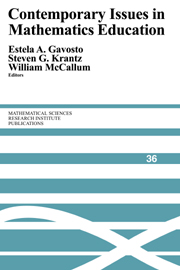Book contents
The Research Mathematician as Storyteller
Published online by Cambridge University Press: 27 June 2025
Summary
The Southwest Regional Institute in the Mathematical Sciences (SWRIMS) was funded by the National Science Foundation (NSF) as an effort to integrate research and education. Part of the NSF's vision is that the researcher should be simultaneously involved in research activities and educational initiatives. One of the purposes of SWRIMS was to bring into focus what these educational initiatives might be, and to answer the following questions: How can a researcher use research, especially personal achievements in research, to further the educational goals of the mathematics community? How can this research be used to motivate our children to pursue higher mathematical studies? One of us addressed these questions in [5], which catalogued SWRIMS activities for the academic year 1995-96 at its three funded sites (University of Arizona, Northern Arizona University and Utah State University), and formulated some ideas for integrating research and education. The present article aims to highlight the products of one of these activities and to remind the mathematics research community of its teaching role in our society and its responsibility for transmitting our mathematical knowledge to the community.
It is the role of teacher that we have come to re-think as we carried out our SWRIMS activities. This role is very nicely articulated by Robert A. Williams, Jr., in his foreword to The Rodrigo Chronicles [2]. Williams, drawing from his background as a member of the Lumbee tribe, states:
In the Native American tradition, to assume the role of Storyteller is to take on a very weighty vocation. The shared life of a people as a community is defined by an intricate web of connections: kinship and blood, marriage and friendship, alliance and solidarity. In the Indian way, the Storyteller is the one who bears the heavy responsibility for maintaining all of these connections.
Information
- Type
- Chapter
- Information
- Contemporary Issues in Mathematics Education , pp. 45 - 56Publisher: Cambridge University PressPrint publication year: 1999
